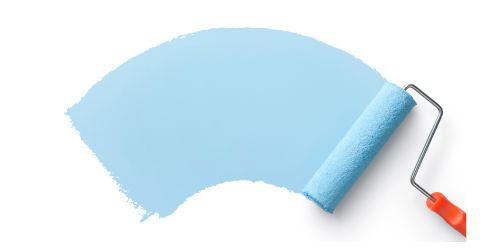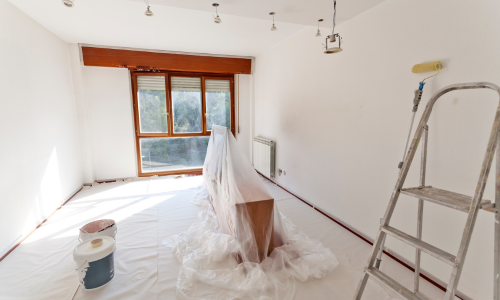When it comes to painting, many people focus solely on choosing the right paint color and quality. However, the type and size of paint roller cover you use is an equally important aspect of getting the best results. Paint roller covers are essential tools that help you achieve smooth and even paint application on various surfaces. They are available in different sizes, materials, and styles, each designed for specific purposes. Understanding the importance of paint roller covers and knowing how to choose the right size are crucial steps towards achieving a professional-looking finish.
Different Types of Paint Roller Covers
Before we delve into the specifics of paint roller cover sizes, it's important to familiarize yourself with the different types of covers. The type of paint roller cover you choose depends on the surface you are painting and the type of paint you are using. Here are some common types of paint roller covers:
-
Synthetic Roller Covers: These covers are made from synthetic materials like polyester or nylon. They are suitable for smooth surfaces and work well with latex or water-based paints.
-
Natural Fiber Roller Covers: Made from natural fibers such as sheepskin or mohair, these roller covers are ideal for applying oil-based paints or stains. They provide a smooth finish and are great for textured surfaces.
-
Foam Roller Covers: Foam roller covers are perfect for achieving a smooth and flawless finish on smooth surfaces. They work well with both oil-based and water-based paints; however, they may not hold as much paint as other types of roller covers.
-
Microfiber Roller Covers: These covers are made from microfiber fabric, which holds more paint and provides excellent coverage. Microfiber roller covers are suitable for both smooth and textured surfaces and work well with all types of paints.
Factors to Consider When Choosing Paint Roller Cover Sizes
Now that you have an understanding of the different types of paint roller covers, it's time to look at the factors to consider when choosing the right size. The size of the roller cover you use depends on the surface area you need to cover, the texture of the surface, and the type of paint you are using. Here are some important factors to consider:
-
Surface Area: The size of the roller cover should be proportional to the size of the surface you are painting. For large areas, a wider roller cover will help you cover more ground quickly. However, for smaller areas or tight spaces, a narrower roller cover will provide better control and precision.
-
Texture of the Surface: If you are painting a textured surface, such as a stucco wall or a popcorn ceiling, a thicker roller cover with a longer nap will help you reach into the crevices and achieve better coverage. Smoother surfaces, on the other hand, require roller covers with a shorter nap.
-
Type of Paint: Different types of paint require different roller cover sizes. For example, thick paints like primer or masonry paint may require a larger roller cover to hold more paint and provide better coverage. Thinner paints, such as stains or water-based paints, can be applied with a smaller roller cover.
Consider these all of these factors when choosing the size of your paint roller cover to ensure optimal paint application and a smooth finish.
Popular Paint Roller Cover Sizes and Their Uses
Paint roller covers come in a range of sizes, each serving a specific purpose. Here are some popular paint roller cover sizes and their uses:
-
4-inch Roller Cover: This smaller roller cover is ideal for painting narrow or tight spaces, such as trim, corners, or edges. It provides better control and precision when working in confined areas.
-
9-inch Roller Cover: The 9-inch roller cover is a versatile size that is commonly used for painting larger areas, such as walls or ceilings. It provides good coverage and allows you to complete your project efficiently.
-
18-inch Roller Cover: The 18-inch roller cover is suitable for large-scale projects, such as painting wide walls or floors. It covers a larger surface area in less time, making it a preferred choice for professional painters or those tackling extensive painting projects.
-
Mini Roller Cover: Mini roller covers are typically 3 to 4 inches wide and are perfect for touch-ups, small projects, or hard-to-reach areas. They are easy to maneuver and provide excellent control.
These are just a few examples of popular paint roller cover sizes but there are many other sizes available. It's important to choose the size that best suits your project to ensure efficient and effective paint application.
How to Determine the Right Paint Roller Cover Size for Your Project
Now that you know the different sizes and types of roller covers that are available, here are some steps to help you determine the ideal size for your project:
-
Evaluate the Surface: Assess the surface you will be painting. Determine if it is a large area, a narrow space, or a textured surface. This will help you narrow down the appropriate roller cover size.
-
Consider the Paint Type: Take into account the type of paint you will be using. Thicker paints may require a larger roller cover nap size to hold more paint, while thinner paints may work well with a smaller, thinner nap roller cover.
-
Test and Adjust: If you are unsure about the roller cover size, start with a smaller size and test it on a small area. Assess the coverage and adjust accordingly. This will allow you to fine-tune your choice before committing to the entire project.
By following these steps, you can determine the right paint roller cover size and achieve the best results for your specific project.
Tips for Using Paint Roller Covers Effectively
Using paint roller covers effectively can greatly impact the quality of your paint job. Here are some tips to help you get the most out of your roller covers:
-
Prep the Roller Cover: Before using a new roller cover, remove any loose fibers or debris by rolling it over a piece of tape or a lint roller. This will prevent any unwanted particles from ending up on your painted surface.
-
Load the Roller Cover Properly: Dip the roller cover into the paint tray and roll it back and forth to evenly distribute the paint. Avoid overloading the roller cover, as this can lead to drips or uneven application.
-
Use the Right Technique: When applying paint, use smooth and even strokes. Using the "W" method works well to povide even coverage. Simply apply the paint in a "w" shape and then work your way back across without lifting the roller cover. Start from the top and work your way down, overlapping each stroke slightly. This will help you achieve an even and uniform finish.
-
Clean and Store Properly: After each use, clean the roller cover thoroughly to remove any excess paint. Follow the manufacturer's instructions for cleaning. Once clean, store the roller cover in a plastic bag or wrap it tightly in plastic wrap to keep it in good condition for future use.
By following these tips, you can ensure that your paint roller covers perform optimally and help you achieve a professional-looking finish.
Expert Recommendations for Specific Projects and Paint Types
For specific projects and paint types, our experts have shared some of their top tips from their combined decades of experience:
-
Textured Surfaces: When painting textured surfaces, such as stucco or textured wallpaper, opt for roller covers with a longer nap, typically ¾ inch or longer. This will help you reach into the crevices and achieve better coverage.
-
Smooth Surfaces: For smooth surfaces, such as drywall or wood, roller covers with a shorter nap, around ⅜ inch, work well. They provide a smooth finish without leaving behind any texture.
-
High-Gloss Paints: When using high-gloss paints, choose a roller cover with a shorter nap to minimize the appearance of roller marks. A microfiber roller cover is often recommended for achieving a flawless finish.
-
Large Areas: When painting large areas, such as walls or ceilings, consider using a wider roller cover, such as a 9-inch or 18-inch size. This will help you cover more surface area quickly and efficiently.
Common Mistakes to Avoid When Choosing Paint Roller Covers
When choosing paint roller covers, it's important to avoid common mistakes that can lead to subpar results. Here are some mistakes to avoid:
-
Using the Wrong Nap Length: Choosing a roller cover with the wrong nap length can result in an uneven finish or poor coverage. Always consider the texture of the surface and the type of paint you are using when selecting the nap length.
-
Overlooking the Surface Area: Neglecting to consider the surface area you need to cover can lead to inefficiency or the need for frequent reloading of paint. Ensure that the roller cover size matches the scale of your project.
-
Ignoring the Paint Type: Different types of paint require different roller cover sizes. Using the wrong size for a particular paint can result in difficulty in application or inadequate coverage.
-
Not Testing the Roller Cover: Failing to test the roller cover on a small area before committing to the entire project can lead to disappointment. Always test the roller cover size to ensure it meets your expectations.
By being aware of these common mistakes, you can make informed decisions when choosing paint roller covers and avoid unnecessary problems during your painting project.
Conclusion: Finding the Perfect Paint Roller Cover for Your Project
Choosing the perfect paint roller cover size is essential to achieving a professional-looking paint job. By understanding the importance of paint roller covers, familiarizing yourself with the different types available, and considering factors such as surface area and paint type, you can make an informed decision. Remember to follow expert recommendations, avoid common mistakes, and use your roller covers effectively for the best results.
Get the right type of roller cover for your project and embark on your painting journey with confidence. Whether you're painting a small room or tackling a large-scale project, the perfect paint roller cover size will help you achieve a flawless finish. Happy painting!



